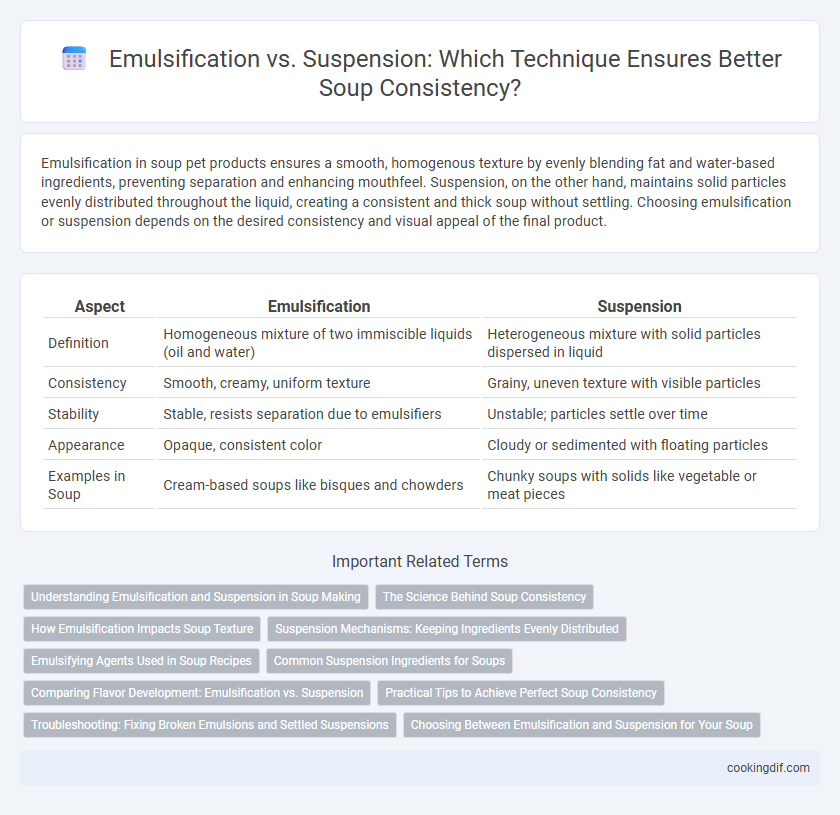Emulsification in soup pet products ensures a smooth, homogenous texture by evenly blending fat and water-based ingredients, preventing separation and enhancing mouthfeel. Suspension, on the other hand, maintains solid particles evenly distributed throughout the liquid, creating a consistent and thick soup without settling. Choosing emulsification or suspension depends on the desired consistency and visual appeal of the final product.
Table of Comparison
| Aspect | Emulsification | Suspension |
|---|---|---|
| Definition | Homogeneous mixture of two immiscible liquids (oil and water) | Heterogeneous mixture with solid particles dispersed in liquid |
| Consistency | Smooth, creamy, uniform texture | Grainy, uneven texture with visible particles |
| Stability | Stable, resists separation due to emulsifiers | Unstable; particles settle over time |
| Appearance | Opaque, consistent color | Cloudy or sedimented with floating particles |
| Examples in Soup | Cream-based soups like bisques and chowders | Chunky soups with solids like vegetable or meat pieces |
Understanding Emulsification and Suspension in Soup Making
Emulsification in soup making involves blending immiscible liquids, such as oil and water, into a stable mixture using emulsifiers like lecithin, resulting in a smooth and consistent texture. Suspension refers to dispersed solid particles, such as vegetable bits or spices, suspended throughout the liquid, giving soups a thicker, chunkier consistency without homogenization. Mastering the balance between emulsification and suspension enhances soup quality by ensuring optimal mouthfeel and uniform flavor distribution.
The Science Behind Soup Consistency
Emulsification in soup involves the stable blending of oil and water molecules, creating a smooth and creamy texture by forming tiny droplets that resist separation. Suspension relies on finely dispersed solid particles throughout the liquid, contributing to a thicker but less uniform consistency prone to settling over time. Understanding the balance between emulsification and suspension is essential for achieving the desired soup texture, where emulsifiers like lecithin or mustard stabilize the mixture and suspended solids add body without compromising smoothness.
How Emulsification Impacts Soup Texture
Emulsification creates a stable mixture of fat and water that results in a smooth, creamy soup texture, enhancing mouthfeel and richness. Unlike suspension, where fat droplets remain separate and can cause a grainy or separated texture, emulsification ensures uniform consistency throughout the soup. This process improves the soup's body and prevents ingredient separation, leading to a more appealing and satisfying sensory experience.
Suspension Mechanisms: Keeping Ingredients Evenly Distributed
Suspension mechanisms in soup ensure that solid particles remain evenly distributed throughout the liquid, preventing ingredients from settling at the bottom. This process relies on factors like particle size, viscosity, and continuous stirring to maintain uniform texture and taste. Unlike emulsification, which blends immiscible liquids such as oil and water, suspension focuses on stabilizing dispersed solids within the broth for consistent mouthfeel and appearance.
Emulsifying Agents Used in Soup Recipes
Emulsifying agents such as lecithin, mustard, and egg yolks play a crucial role in achieving a smooth, homogenous soup consistency by stabilizing oil-water mixtures. Unlike suspensions, where particles remain dispersed without binding, emulsions prevent separation, ensuring uniform texture and flavor throughout the soup. These agents improve mouthfeel and appearance, making them essential ingredients in creamy and vinaigrette-based soup recipes.
Common Suspension Ingredients for Soups
Suspension in soups relies on ingredients like starches, flour, and vegetable fibers to evenly disperse solid particles within the liquid, creating a consistent texture without fully blending the components. Unlike emulsification, which combines immiscible liquids such as oil and water into a stable mixture using emulsifiers like lecithin, suspension ingredients maintain visible particles that enhance the soup's body and mouthfeel. Common suspension agents include cornstarch, potato starch, and xanthan gum, which thicken and stabilize soups by trapping solid fragments in the liquid phase.
Comparing Flavor Development: Emulsification vs. Suspension
Emulsification in soup creates a stable mixture by dispersing fat droplets evenly, enhancing flavor integration and producing a rich, creamy texture with consistent taste throughout. Suspension relies on finely chopped or blended ingredients remaining evenly distributed without fully blending, resulting in a more variable flavor profile as fat and solids may separate over time. Emulsified soups like bisques develop deeper, well-rounded flavors compared to suspended soups where flavor bursts can be more pronounced but less uniform.
Practical Tips to Achieve Perfect Soup Consistency
Achieving perfect soup consistency depends on understanding emulsification and suspension techniques; emulsification blends fat and water phases to create a smooth, creamy texture, while suspension keeps solid particles evenly distributed within the liquid. Use high-speed blending or whisking to break down fats and ensure stable emulsions, and employ starches or pureed vegetables to maintain particle suspension without separation. Controlling temperature and gradually incorporating ingredients helps stabilize the soup's body, preventing curdling or settling for a consistent, velvety finish.
Troubleshooting: Fixing Broken Emulsions and Settled Suspensions
Broken emulsions in soups often result from improper mixing or temperature changes causing oil and water phases to separate, requiring vigorous whisking or the addition of emulsifiers like mustard or lecithin to restore smooth consistency. Settled suspensions occur when solid particles in broth sink, creating uneven texture; stirring before serving or incorporating stabilizers like xanthan gum can re-distribute solids effectively. Understanding the molecular interactions between ingredients aids in troubleshooting texture issues to achieve a uniform, creamy soup consistency.
Choosing Between Emulsification and Suspension for Your Soup
Emulsification creates a smooth, cohesive texture by combining oil and water-based ingredients into a stable mixture, ideal for creamy soups like bisques or veloutes. Suspension maintains solid particles evenly distributed without blending them fully, perfect for chunky vegetable or bean soups that require a hearty mouthfeel. Selecting between emulsification and suspension depends on the desired soup consistency and mouthfeel, with emulsification enhancing creaminess and suspension preserving texture.
Emulsification vs Suspension for consistency Infographic

 cookingdif.com
cookingdif.com